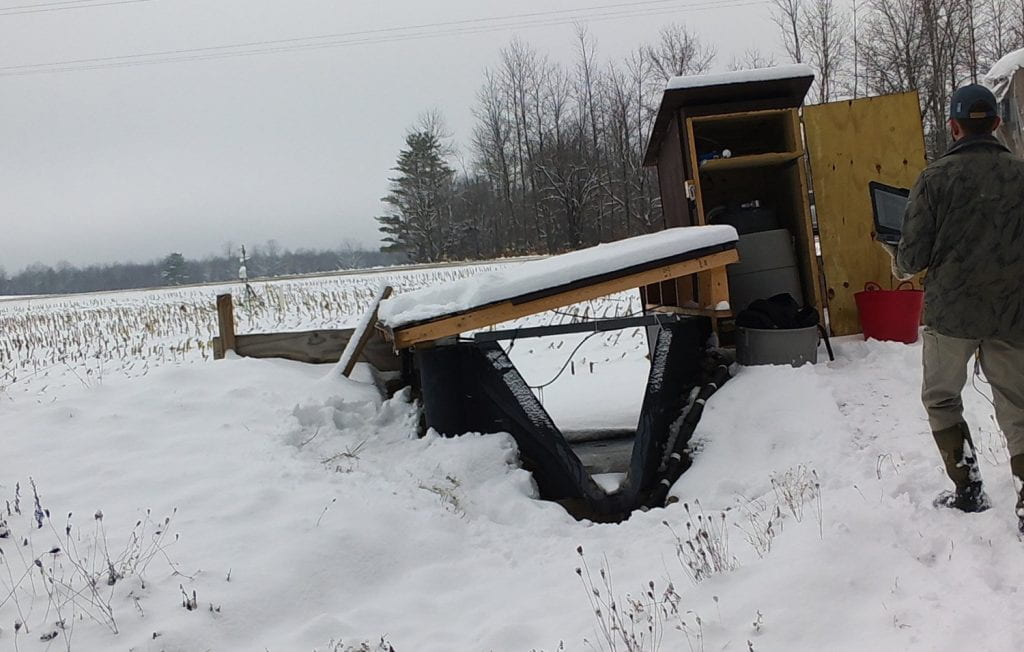
Unprecedented agricultural water quality research funded by the Northern New York Agricultural Development Program (NNYADP) is producing significant insight into how nutrients such as phosphorus and nitrogen are transported across and through soil. On February 24, 2021, project leader Laura Klaiber, a nutrient management researcher at the Miner Institute in Chazy, New York, will present the latest three years of data during the 2021 North Country Crop Congress, held via Zoom.
In her presentation on February 24, Klaiber will share key points from year-round, edge-of-field research trials that have captured field surface and tile drainage runoff with monitoring equipment on a farm in Keeseville, New York. Tile drainage is a critical practice used in crop fields with naturally poorly-drained soils, and in short growing season areas, to significantly enhance and stabilize crop quality and yield.
“The use of tile drainage has come under scrutiny as a potential source of excess nutrients in watersheds. Prior to this Northern New York Agricultural Development Program-supported study, little research had been specifically designed to compare the impacts of common agricultural drainage practices on regional water quality. Now, through the continuous year-round monitoring of nutrient movement in surface runoff and tile drainage in farm fields provided for these trials, we are able to generate data to inform field management practices that will help conserve our natural resources,” Klaiber said.
This northern New York-based research is showing that non-growing season, weather-related events play a critical and consistent role in nutrient transport; however, more data is needed before researchers can more accurately pinpoint how the interactions between weather and field conditions relate to runoff quantity and quality.
“These trials are precedent-setting with insights that can only be developed with long-term studies due to the high variability of runoff rates and nutrient concentrations that occur across events and on an annual basis,” Klaiber said.
Time and intensive study are required to isolate the diverse contributing factors and interactions that influence the biological uptake, release, and transport of agricultural nutrients through soil. The interaction of weather, cropping systems, field management, soil type and fertility, topography and other factors all impact nutrient retention or export from both surface and tile drainage.
“We are encouraged that the data show reductions in exported phosphorus and sediment. This can have important implications for the phosphorus-reduction efforts ongoing in the Lake Champlain Basin; however, this improvement must be considered in balance with the increased risk for nitrogen mobilization. Future research is needed to identify practices, or more likely suites of practices, that can improve both of these water quality parameters simultaneously,” Klaiber noted.
With each successive year of data analysis, the research team is evolving best practices related to manure, nutrient and crop management to help growers enhance production efficiency and farm-based environmental stewardship.
The NNYADP first began collaborating on this groundbreaking tile drainage-related water quality research in 2010. Water resource managers and farmers alike want to know more about the potential differences in soil erosion and the transport of nutrients from fields with and without tile drainage.
Project collaborators have included the New York State Department of Environmental Conservation, which provided land for trials at Lake Alice Wildlife Management Area in Chazy; the Lake Champlain Basin Program; SUNY Plattsburgh; the New England Institute of Water Pollution Control Commission; Champlain Valley Agronomics; River Bend Agricultural Engineering Services; and regional farms.
Klaiber has presented the results of this NNYADP-funded water quality research to agricultural and natural resource interest groups in New York, New England, and nationally through the annual joint meeting of the Soil Science Society of America, Crop Science Society of America, and American Society of Agronomy.
To register for the February 24, 2021 North Country Crop Congress, contact your local Cornell Cooperative Extension office or reach Cornell University Regional Field Crops Specialist Michael Hunter at 315-788-8450 or meh27@cornell.edu.
NNYADP tile drainage project results reports since 2010 are posted at https://www.nnyagdev.org/index.php/2020-nnyadp-projects.
Funding for the Northern New York Agricultural Development Program is supported by the New York State Legislature and administered by the New York State Department of Agriculture and Markets.

